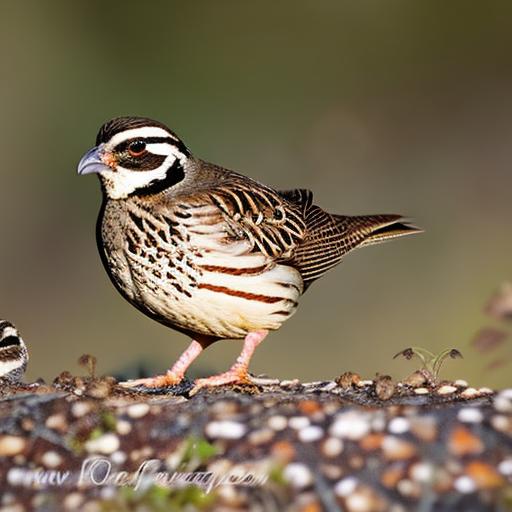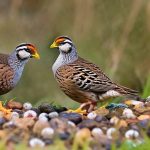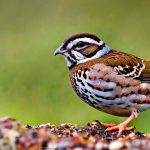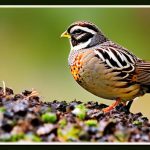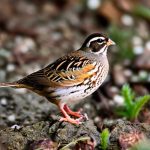Quails are small, ground-dwelling birds that are known for their social behavior and strong flocking instincts. They are typically found in grasslands, meadows, and agricultural fields where they can find cover and food. Quails are also known for their secretive nature, often hiding in dense vegetation to avoid predators. Understanding quail behavior is essential for creating a quail-friendly environment and implementing effective control strategies.
Quails are most active during the early morning and late afternoon, foraging for seeds, insects, and vegetation. They prefer areas with dense cover, such as tall grasses, shrubs, and brush piles, where they can hide from predators and roost at night. Quails are also known for their strong nesting instincts, often building their nests on the ground in hidden locations. By understanding these behaviors, landowners can create a habitat that is attractive to quails and implement control strategies that target their specific habits.
Key Takeaways
- Quail are ground-dwelling birds that prefer open areas with low vegetation and are easily stressed by human activity.
- Creating a quail-friendly environment involves providing suitable cover, nesting sites, and water sources.
- Using physical barriers such as fences and netting can help keep quail out of unwanted areas.
- Planting quail-resistant plants like native grasses and shrubs can provide food and cover for quail.
- Providing alternative food sources like bird feeders and water sources can help deter quail from damaging crops.
Creating a Quail-Friendly Environment
Creating a quail-friendly environment is essential for attracting and maintaining healthy quail populations. This can be achieved by providing suitable habitat, food sources, and nesting sites. Landowners can create a quail-friendly environment by maintaining areas of dense cover, such as native grasses, shrubs, and brush piles. These areas provide quails with the cover they need to hide from predators and roost at night. Landowners can also create suitable nesting sites by leaving patches of undisturbed vegetation and avoiding mowing or tilling during the nesting season.
In addition to habitat management, landowners can also provide supplemental food sources for quails. Planting food plots with quail-friendly plants such as millet, sorghum, and sunflowers can provide quails with a reliable source of food throughout the year. Providing access to clean water sources is also important for maintaining healthy quail populations. By creating a quail-friendly environment, landowners can attract and support quail populations while minimizing the need for control strategies.
Using Physical Barriers
Using physical barriers is an effective way to control quail populations and protect valuable crops and landscaping. Physical barriers such as fences, netting, and bird netting can be used to exclude quails from specific areas. Fences can be used to create a barrier around gardens, orchards, and other high-value crops to prevent quails from accessing them. Netting and bird netting can be used to cover individual plants or entire areas to protect them from quail damage.
When using physical barriers, it is important to ensure that they are properly installed and maintained to be effective. Fences should be tall enough to prevent quails from flying over them and buried into the ground to prevent quails from digging underneath them. Netting should be securely fastened to prevent quails from getting tangled in it or pulling it down. By using physical barriers, landowners can effectively control quail populations and protect their crops and landscaping from damage.
Planting Quail-Resistant Plants
Planting quail-resistant plants is another effective strategy for controlling quail populations and minimizing damage to crops and landscaping. Quails are known for their preference for certain types of plants, including grains, grasses, and legumes. By planting quail-resistant plants, landowners can reduce the attractiveness of their property to quails and discourage them from foraging in specific areas.
Quail-resistant plants include species that are less palatable to quails or have physical characteristics that make them less attractive as food sources. Examples of quail-resistant plants include ornamental grasses, herbs, and woody shrubs that are not typically preferred by quails. By planting these types of plants in areas where quails are causing damage, landowners can reduce the impact of quail populations on their property.
Providing Alternative Food Sources
Providing alternative food sources is another effective strategy for controlling quail populations and minimizing damage to crops and landscaping. By providing alternative food sources, landowners can reduce the attractiveness of their property to quails and encourage them to forage in other areas. This can be achieved by planting food plots with non-preferred plants or providing supplemental food sources such as bird feeders with seeds that are not typically preferred by quails.
In addition to planting alternative food sources, landowners can also implement habitat management practices that encourage the growth of non-preferred plants. This can include mowing or tilling areas where preferred plants are growing to encourage the growth of less palatable species. By providing alternative food sources, landowners can effectively control quail populations and minimize damage to their property.
Using Repellents

Using repellents is another effective strategy for controlling quail populations and protecting valuable crops and landscaping. Repellents are substances that deter quails from foraging in specific areas by making them unpalatable or creating an unpleasant sensory experience. There are a variety of repellents available for controlling quail populations, including chemical repellents, visual repellents, and auditory repellents.
Chemical repellents can be applied to plants or other surfaces to make them unpalatable to quails. Visual repellents such as scarecrows or reflective tape can be used to create a visual deterrent that discourages quails from entering specific areas. Auditory repellents such as ultrasonic devices or predator calls can be used to create an unpleasant sensory experience that deters quails from foraging in specific areas. By using repellents, landowners can effectively control quail populations and protect their crops and landscaping from damage.
Monitoring and Adjusting Strategies
Monitoring and adjusting strategies is essential for effectively controlling quail populations and minimizing damage to crops and landscaping. By monitoring the effectiveness of control strategies, landowners can identify areas where quails are still causing damage and make adjustments as needed. This can include implementing additional control measures or modifying existing strategies to better target specific areas or behaviors.
In addition to monitoring the effectiveness of control strategies, landowners should also monitor quail populations to ensure that they are not being negatively impacted by control measures. This can include conducting population surveys or monitoring nesting success to ensure that quail populations remain healthy. By monitoring and adjusting strategies, landowners can effectively control quail populations while minimizing the impact on the overall ecosystem.
In conclusion, understanding quail behavior is essential for creating a quail-friendly environment and implementing effective control strategies. By creating a habitat that is attractive to quails and providing suitable food sources and nesting sites, landowners can support healthy quail populations while minimizing the need for control measures. Using physical barriers, planting quail-resistant plants, providing alternative food sources, using repellents, and monitoring and adjusting strategies are all effective ways to control quail populations and protect valuable crops and landscaping. By implementing these strategies, landowners can effectively manage quail populations while minimizing damage to their property.
If you’re looking for ways to protect your garden from quail and other poultry, you might find the article “Garden Chicken Coop: How to Keep Your Plants Safe” on PoultryWizard.com helpful. This article provides valuable tips and strategies for creating a chicken coop that not only keeps your chickens safe but also prevents them from damaging your garden. With insights on coop design and placement, it offers practical solutions to keep quail and other poultry from eating your plants. Check out the article here for expert advice on maintaining a harmonious balance between your garden and your feathered friends.
FAQs
What are some effective methods to keep quail from eating plants?
Some effective methods to keep quail from eating plants include using physical barriers such as fences or netting, planting quail-resistant plants, providing alternative food sources for the quail, and using repellents or deterrents.
What are some quail-resistant plants that can be planted to deter quail from eating other plants?
Some quail-resistant plants that can be planted to deter quail from eating other plants include lavender, rosemary, sage, yarrow, and ornamental grasses. These plants have strong scents or textures that quail tend to avoid.
What are some alternative food sources that can be provided to quail to prevent them from eating plants?
Some alternative food sources that can be provided to quail to prevent them from eating plants include seeds, grains, and specially formulated quail feed. By providing these alternative food sources, quail may be less inclined to eat plants in the garden.
What are some natural repellents or deterrents that can be used to keep quail away from plants?
Some natural repellents or deterrents that can be used to keep quail away from plants include garlic or chili pepper sprays, predator decoys, and motion-activated sprinklers. These methods can help deter quail from entering the garden and eating plants.
Meet Walter, the feathered-friend fanatic of Florida! Nestled in the sunshine state, Walter struts through life with his feathered companions, clucking his way to happiness. With a coop that’s fancier than a five-star hotel, he’s the Don Juan of the chicken world. When he’s not teaching his hens to do the cha-cha, you’ll find him in a heated debate with his prized rooster, Sir Clucks-a-Lot. Walter’s poultry passion is no yolk; he’s the sunny-side-up guy you never knew you needed in your flock of friends!

